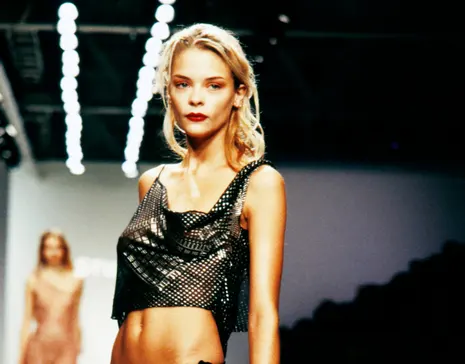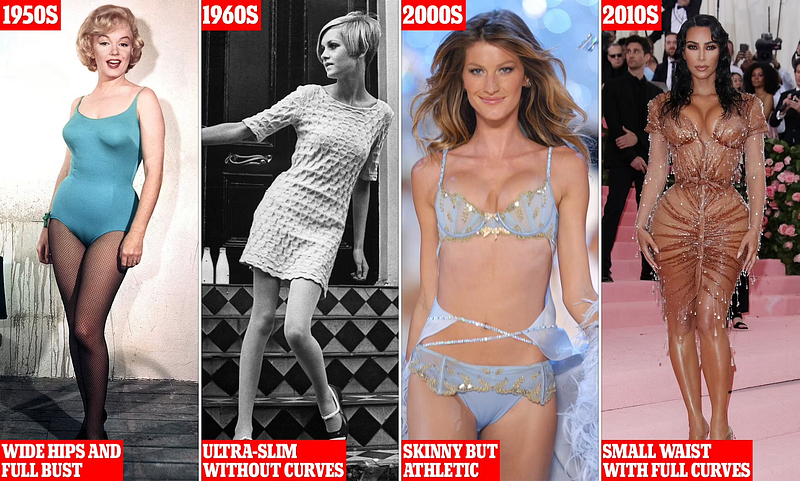The Comeback of Heroin Chic
‘’American fashion has been an enormous source of creativity and beauty and art and, frankly, economic prosperity for the United States…

Headlines in the New York Post and Insider have expressed to their readers that the heroin chic trend has resurfaced in the fashion industry. This statement was formed after the circulation of celebrities removing their BBL implants, celebrities contributing to the Ozempic drug shortage, and the surge of buccal fat removal surgery.
It is notable however, that conversations on body diversity have increased over the past few years, and there is a surge of size-inclusive brands and the appearance of plus-size models such as Yumi Nu and Paloma Elsesser in high-profile advertising campaigns. Although this would seem like progress in the fashion industry, it’s two steps forward and three back in fashion. Skinny models have never gone out of trend, with only three plus-size models currently ranked in the Top 50 on the industry website Models.com.
90 of the 247 brands from the spring/summer 2023 ready-to-wear season, held in September in New York, London, Milan and Paris, included plus-size models according to fashion search engine Tag walk. Thin models were able to showcase the celebration of Y2K and ’90s-inspired designs, with low-slung pants at Alexander McQueen, abdominal cut-outs at Miu Miu and hip-revealing dresses at Bally. The most viewed look from Paris Fashion Week was model Bella Hadid at Coperni having a dress sprayed onto her thin, nearly naked, form.
Not everyone feels as though they can engage with these trends, especially when they are not being created in larger sizes. To have the narrative that your body needs to be pushed towards a certain version is concerning. It’s a massive step backwards.
The Origins of the Heroin Chic Trend

During the early 90s, the fashion industry predominantly consisted of waifish models with pale skin and dishevelled hair. At this point in time, most of the famous fashion campaigns were led by a young Kate Moss, who infamously declared that “nothing tastes as good as skinny feels”, and documented by photographers like Davide Sorrenti and Corinne Day, the trend was controversially named the “heroin chic”.
Although the pattern of fashion trends is always a cycle, thin bodies remained a mainstream ideal for almost another two decades. In the early 2000s promoting unhealthily thin bodies was rampant on largely unmonitored online forums and communities like Tumblr. With the prevalence of pro-anorexia content and the glamorisation of depression and drugs, in many ways, the “Tumblr Girl aesthetic” was just the “heroin chic” repackaged for teens.
Heroin Chic on Young Women

The dangers of rapidly changing body ideals and the pressure on women to keep up with them have been widely discussed by mental health professionals, eating disorder survivors, and body-positive influencers.
Particularly in the teenage years, our bodies go through changes that can cause distress, discomfort, and confusion. It’s also during our teenage years that we feel the intense pressure and expectation to look a particular way, which can result in eating disorders, self-harm, over-exercising, and other body image issues. Social media is unfortunately shaping our concept of beauty. With the constant exposure to images posted online, it is evident that there is a link to how individuals compare themselves and perceive their own bodies. Now more than ever, young people’s bodies can be watched and scrutinised 24 hours a day. With celebrities and role models posting highly edited images online; selling weight loss teas, pills, diets, and exercise routines, there is a constant pressure to fit in with the latest trends. Such content perpetuates a pervasive narrative of inadequacy inside the minds of young, impressionable, and often already perfectly healthy young women.
Approximately 28.8 million Americans have experienced an eating disorder in their lifetime, as they affect people of all genders, ages, sexual orientations, and socio-economic backgrounds. Eating disorders are the second most deadly mental illness, yet popular media is fuelling widespread disordered eating through the active glorification and sale of diet culture, and weight-loss and beauty products. Diet culture is now often carefully masked as a “healthy lifestyle” to sell an ideal that is almost always unattainable. It fundamentally values appearance and thinness above health, conflating thinness with moral virtue.
If young women are constantly told to appear skinnier, it could pose a threat to their health, as their bodies are still growing and changing from adolescence to adulthood. Not to mention that they’re still forming their identities and learning what it means to be healthy. If young women are constantly surrounded by messages about restrictive eating, calorie counting, “skinny ideals’ ‘ and “clean/dirty” foods, they will begin to equate size with their self-worth. What may begin as trying out the latest diet trend for summer can quickly become an obsession. The National Eating Disorders Association found that 35% of dieting becomes obsessive and that 20 to 25% of those diets turn into eating disorders.
Body Ideals Throughout the Years

Women’s bodies have been the subject of scrutiny since the dawn of time. An hourglass form with rounder hips and tummies and a larger bust was most desired throughout the Italian Renaissance and Victorian times. In the 1920s, ladies with slender, flat chests were deemed to be the most attractive. Curvy bodies akin to Marilyn Monroe’s became the most coveted and widely accepted in Hollywood and other places between the 1930s to 1950s. But, once more, the 1960s brought back the ominously described “adolescent body,” which included long, slender legs, flat chests, and flat waists. The 1980s then celebrated an athletic, “toned” body that was svelte but curvy, with workout videos spurring a “fitness craze” that lasted until the 1990s, when “heroin chic” became desirable. The ideal body type has now evolved larger throughout the 2000s, with Kim Kardashian frequently acclaimed as the poster woman for these standards because of her huge, full breasts, broad hips, tanned skin, and curvaceous figure.
How Do We Stop This?
Overall, if we want to surf the inevitable waves of fashion with our body image and sense of self-worth intact, we must start to accept how our bodies look. Because so many manufacturers and designers don’t offer size-inclusive lines, the notion that our bodies must fit a certain mould in order to wear the latest trends is what oppresses us, not the shifting fashion trends themselves. However, this notion is unfounded and is readily refuted if we simply wear the fashions we enjoy regardless of our body size.
Fashion is displayed on bodies; bodies are not fashion. If, as a society, we can learn to separate the two, we can wear whatever comes down the runway at us next. Fashion is displayed on our bodies, our bodies are not the fashion. If we as a culture can learn to distinguish between the two, we will be able to handle whatever comes our way next.
[Written by: Harshaall. Edited by: Ruby]

